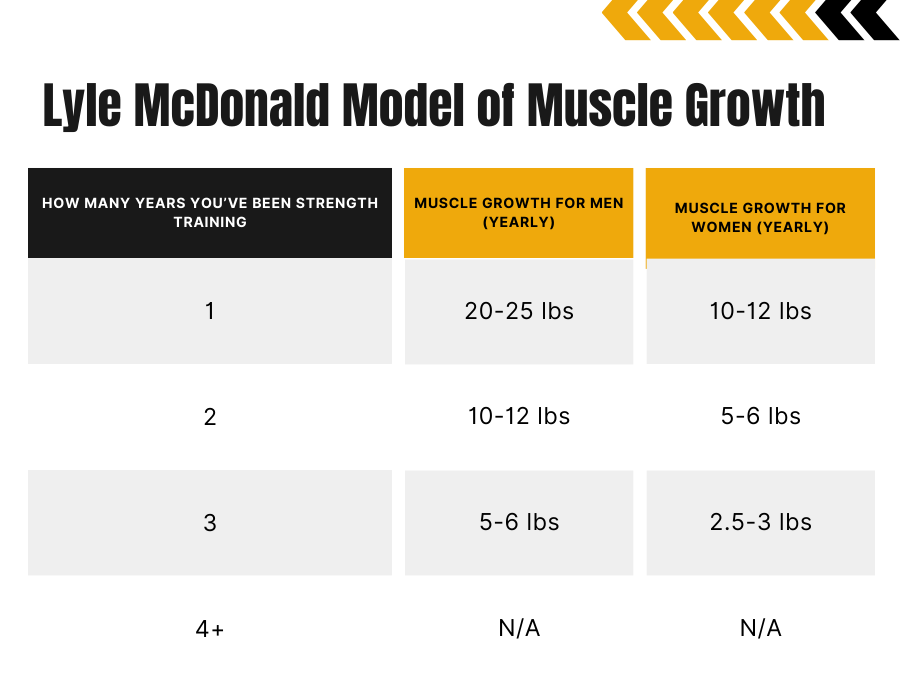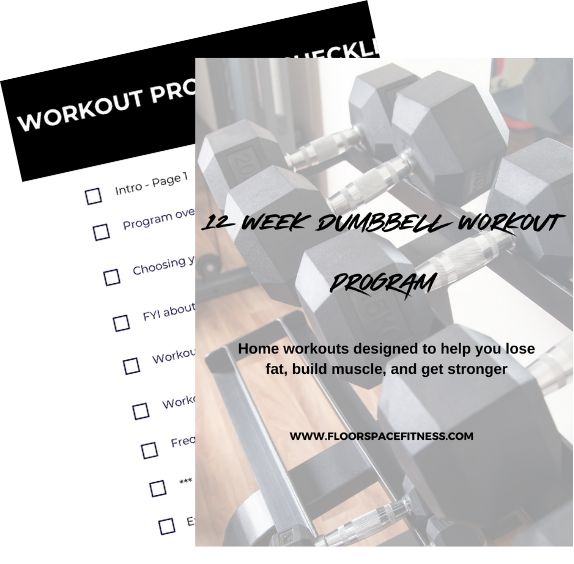
IN THIS POST
Learn how long it takes to build muscle, the different factors that play into it, and what you can do to build muscle as fast as possible.
Pin this post so you can always come back to it.
And share this article with a friend if you find it useful. 💪🏾

Introduction
A bigger chest and bigger arms.
Thicker, juicer quads.
Rounder, more pronounced, and shapely glutes.
They all require one thing…
Muscle.
But how fast can you build it?
You’ll get the answer to that question right now, right off the bat.
But make sure you stick around until the end.
We’ll also be talking about:
- The different factors that play into how long it takes to build muscle
- How you can build muscle ASAP

How fast can you build muscle?
According to the Lyle McDonald Model of Muscle Growth, on average, men can expect to gain around 20-25 pounds of muscle in their first year of being on a proper strength training plan (So, roughly 2 pounds per month).
Women can gain about 10-12 pounds in their first year, which is approximately 1 pound per month.
As you can see from the chart, the longer you strength train, the slower your rate of muscle growth.
FYI, the model also assumes a few things:
- You’re on a proper strength training plan (not switching up your workout routine every single day or doing random workouts).
- Your diet is in order.
- You’re not taking any performance enhancers or anything like that.

What factors influence muscle growth?
Genetics
The same way some people have faster metabolisms than others, some people will have an easier time gaining muscle and will be able to gain more muscle over their lifetime.
Nutrition
Overall calories and protein intake are most important.
Let’s start with the calories piece.
To build muscle you have to be in a “calorie surplus,” which is when you’re consuming more calories than you burn.
In other words, calories in > calories out.
Your body takes that extra fuel and uses it to build muscle.
I should point out that if you’re brand new to strength training, have taken extended time away from the gym (and by extended we’re talking 6+ months), or have never been on a structured strength training plan, you can do something special.
You can be in a calorie deficit (the one thing you need for fat loss) while simultaneously building muscle.
Or to put it another way, you can lose fat AND build muscle at the same time.

Protein:
What are the chances you step outside today and see a living, breathing leprechaun on your front porch standing next to a pot of gold?
0%.
The chance of you building without protein…
0% as well.
Protein isn’t just kind of important, it is THE KEY to building muscle.
You body needs it to repair your muscles between workouts so they can grow back bigger and stronger.
How much protein each day is ideal?
0.7g-1g per pound of your body weight.
If you weigh 200 pounds, for example, you’d eat somewhere between 140 grams and 200 grams of protein every single day.
Related: 5 simple ways to eat more protein (+ a comprehensive list of high-protein foods).
Strength training
I’ll talk about this in more detail in the ”tips to build muscle as fast as possible” section but just know these two things:
1.) You need to attack your workouts with a high intensity (pushing within 1-2 reps shy of failure on all your sets).
2.) You need to lift heavy weights (not exclusively “lighter weights for reps”) if you want to see progress. Keep in mind the word “heavy” varies from person to person.
Related: 3-day dumbbell workout plan.
Recovery
Recovery is a key part of making progress so please, for the love of all things fitness, drop the “I can sleep when I’m dead” mentality.
You can’t always grind, grind, grind and expect to see results.
Here’s what solid recovery looks like:
- Aim for 7-9 hours of sleep each might: Even if you can’t hit that, half an hour or an hour more than what you currently get will make a big difference.
- Consume enough protein (0.7g-1g per pound body weight) to help repair your muscles.
- Have a deload week every 4-6 weeks where you scale back on training volume (how many sets and reps you do) and/or how much weight you lift.
- Have rest days built into your workout schedule: I’d suggest either 3 or 4 rest days per week. If you’re giving max effort on your workout days, your rest days will be a much needed break from training!
Sex
You’ll notice that in the McDonald Model of Muscle Growth women won’t gain as much muscle as men over their lifetime.
Why is this?
Well, men have more testosterone, which is a key component of muscle growth.
But here’s the thing…
Even though women won’t produce the same amount of total muscle men can, the rate at which they build muscle is right on par with men.
Take muscle growth in year 1, for example.

A gain of one pound per month for women divided 10 total pounds for the year = 10%.
You get that same 10% when doing the calculation for men–
2 pounds in muscle gain per month / by 20 total pounds of muscle for the year = 10%.
See what I mean?
Training age
This refers to how long you’ve been strength training.
At the beginning of your weightlifting journey, you’ll able to build muscle more quickly.
That’s because strength training is new to you and your body reacts drastically to it (in a good way).
However–and I mentioned this towward the beginning–the longer you’ve been strength training the slower your rate of muscle growth.
7 tips to put on muscle as fast as possible
1. Follow a program
This is what an actual program is (anything else you can just ignore):
Doing the same batch of workouts for 4-8, maybe 12 weeks at a time.
There is no such thing as switching things up to “confuse your muscles.”
A strength training program will deliver you the best results possible.

2. Make most of your exercises compound movements
You need to prioritize compound movements in your workout routine.
Compound exercises like squat, deadlift, and bench press give you the most bang for your strength training buck.
They allow you to work multiple muscle groups at once (**clutch**) and lift the heaviest amount of weight (**also very clutch**).
Isolation movements like bicep curls and tricep extensions work just one muscle group at a time.
You want to think of these as he icing on top of the cake with your workouts.
3. Take advantage of progressive overload
Progressive overload = gradually increasing the amount of weight you lift over time.
It’s the stimulus your body needs to adapt and build muscle and it’s importance just cannot be overstated.
You’ll walk on water before you achieve results in the absence of progressive overload.

4. Eat in a calorie surplus
Let’s go into a little more detail on your calorie surplus.
You know it means taking in more calories than you burn, so how many calories should you eat each day?
Here’s how to figure out your surplus calories:
Step 1 → Find your TDEE (total daily energy expenditure) using this calculator. Put in all the info it asks for and it’ll provide you with that number. Your TDEE is how many calories you’d need to eat to maintain your current weight.
Step 2 → Take your TDEE and multiply it by 1.1. Those are your surplus calories. Eat that number of calories every single day.
For example, if you weigh 200 pounds you’d eat 2,200 calories per day (2,000 x 110% – 2,200).
5. Fill up on protein and carbs
Fun fact about strength training you might not know:
It causes tiny micro tears in your muscle fibers.
Protein, as I mentioned earlier, is key to recovery.
Your body goes through a process called muscle protein synthesis during which amino acids–the building blocks of protein–repair your muscles between workouts and make them grow.
In a nutshell, lack of protein in your diet stunts the muscle growth process.
As for carbs, they’re your body’s main fuel source and they provide you with energy to crush your workouts so don’t shy away from them.
6. Sleep
Remember how we talked about recovery earlier and getting enough sleep?
You produce less testosterone and HGH (human growth hormone) when you get insufficient sleep, which play pivotal roles in muscle-building.
You’ll also have less energy and be more lethargic in the gym.
That translates to poorer workout performance and less results for you.
7-9 hours each night is ideal but again, 30-60 minutes more a night can be extremely beneficial.
7. Stay consistent and remain patient
Your results are a direct reflection of how consistent you are.
You can’t be on top of things for a week or two then fall off for a few weeks and expect to see any type of meaningful progress.
I don’t want you thinking you have to be perfect though, you just have to be consistent.
Consistently good > inconsistently perfect.
Take that to heart and focus on being on top of things MOST OF THE time, not all the time.
Also, realize this…
There is no such thing as instant gratification when it comes to building muscle.
It’s a slow process.
The truth is, you’ll probably want it to go waaaay faster than it actually will.
But that’s where patience comes into play.
You need to think long-term here and lean into the fact good things don’t come easy.
If they did, everyone would sign up to build muscle and receive all the benefits it provides!

What's up?
I’m Chad, I’m happy you’re here! I’m a certified personal trainer and my goal is to help you form practical, sustainable habits that lead to lifelong fitness results. If you want to lose fat, build muscle, and live a healthier, happier life then you’re right where you need to be. 💪🏾
Free resources
⬇⬇⬇







0 Comments